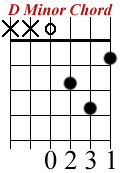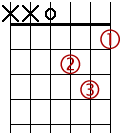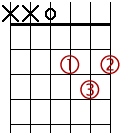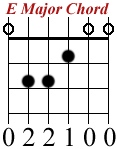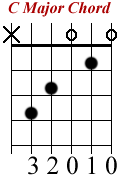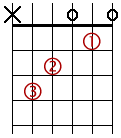Guns n Roses – Patience
One of the easiest and nicest songs to play is patience by guns n roses, perfect song to practice once you get the hang of the basic chords.
PATIENCE (by Guns n Roses)
===========================
Intro:
C G A D C G A D
C G C Em C G D D
C
Shed a tear ...
G
I'm still ...
A D
Girl I think about ...
C
Was a time ...
G
But you set my ...
A D
There is no doubt, ...
C G
Said woman ...
C Em
It will work itself ...
C G D
All we need is just ...
C G
Sad sugar ...
C Em
It comes ....
C G D
All we need is...
Sit here on the...
D
We don't ...
D
Ahh and never ....
D
Cause I ...
Solo
G C
A little p...
G C
Mhh Yeah
G
I've been walking ...
C
Just trying to ...
G
It's hard to see with ...
C
you know I don't like ...
G
And the streets don't change ...
C
I ain't got time for ...
G
Cause I ...
C
Yeah Yeah ...
G
Uh I ...
D
Woh I ...
G C G
Uhh ...
Did anyone figure out the Intro and Solo ?
Your posting would be appreciated!
Have fun playing it!!!!!
Chord correction
After the solo, instead of playing G you play D and
instead of C you play G
Then,when you hear
"woh I need you"
you must play C,and the last line is D G D
I'd like also to suggest a figure that I worked out
for D at the end of
verses and choruses
e|----2--2--0--2--4--2--0--2--
B|----3--3--0--3--3--3--0--3--
G|----2--2--2--2--2--2--2--2--
D|----------------------------
A|----------------------------
E|----------------------------
Learning to play the Acoustic Guitar
On this site you will find free basic guitar lessons, chords and easy acoustic songs to help you learn the acoustic guitar. I started up this blog in September 2008 because after learning the acoustic guitar and playing it for two years I wanted to write some of the basics and help others learn the acoustic guitar like I did. I do have to mention that after being taught some of the absolute basics, I actually learned to play the guitar entirely from lessons online and a great course that I bough.
If you are new to the guitar then I suggest first that you learn the basics, like the parts of the guitar and then move onto to basic techniques like the hammer-on and pull off etc. Once you learn all the open chords and can play them and switch between them easily then you can try out some easy guitar songs. Learning the guitar is hard work but once you have its absolutely fantastic. I hope you find the information on this site useful and as time goes on Ill be adding more lessons and more songs to help you learn acoustic guitar.
learning the acoustic guitar
Once you have seen and understood the basics that i have on this site and you really want to take it a step further then i recommend you work your way up to the intermediate and advanced lessons through a structured course. You can try the one i used which took me from a scratchy player getting confused and frustrated with all the “free” advanced lessons out there. You can check out the Jamorama review i wrote and see if that program works out for you.
Open Chords
In this post we’re going to look at open guitar chords. Chords are formed by placing your fingers on one more frets and strumming the guitar. Open guitar chords are the most basic and fundamental of everything you learn when you start off learning to play a guitar . This is definitely the first thing every guitarist should learn because it is the foundation for so many songs, you would be surprised how many really popular songs are just three open chords. I have to warn you though, they are not easy to play. It takes a lot of time and a lot of practice to be able to play well and change between them quickly. It seems tough at first but keep playing and eventually it becomes much easier until you can play them and switch between them without even looking at the guitar.
The best advice to start off with is to put your fingers into these positions and playing the chord, play it once, play it twice and get a feel for it, and try to keep your fingers away from the other string that way you can minimize any additional noise. This will definitely take some practice. Chords like C, E, Em, A, Am and Dm aren’t too bad and it shouldn’t take you too long to get used to them. Just remember, practice is everything.
When you are eventually used to playing some of these chords, find some easy guitar songs and try playing along or just strumming as practice.
Learn guitar chords (Major):
The C Major Chord
formed x32010
The E Major Chord
formed 022100
The A Major Chord
formed x02220
The G Major Chord
formed 320003 or 320033
The D Major Chord
formed xx0232
Learn guitar chords (minor):
The E Minor Chord
formed 022000
The A Minor Chord
formed x02210
The D Minor Chord
formed xx0231
The Bend
The bend is the most versatile and useful technique available to guitarists. Very few instruments have the luxury of being able to bend notes. Pianos, trumpets, and saxophones cannot easily bend notes. As my guitar teacher said, “Because guitarists can bend notes, it means they have to bend notes!” The bend is the most complicated introductory technique, because it takes the most practice and coordination to execute correctly, and because there are many types, but with practice it should be easy. Bends are indicated in tab notation as follows:
prebend
1/2 1 1/2 1/2
+ + + + + + + +
e:-----------------|------------------|
B:-7^~~~---7^~~~---|-7^~~r------^7~~r-|
G:-----------------|------------------|
D:-----------------|------------------|
A:-----------------|------------------|
E:-----------------|------------------|
The first bend is a bend of 1/2 step on the second string 7th fret.
The second bend is a bend of 1 step on the second string 7th fret.
The third bend is a bend-and-release of 1/2 step on the second string 7th fret.
The fourth bend is a prebend of 1/2 step on the second string 7th fret, with a release.
The Basic Bend
The first bend shown in the above figure is accomplished by fretting the second string 7th fret (usually with your ring finger), picking the note, and actually pushing the string sideways to bend it. Keep the string pressed firmly against the fret, and make sure you keep your finger on the same fret (don’t slide up or down to a different fret). When the pitch of the string increases by one half step, you have correctly executed this bend. To play the second bend, use the same technique, but bend the string until the pitch increases by one step. The most important part of the bend is making sure you bend to the exact pitch. If you don’t, it will sound awful. It is usually easiest if you fret with your ring finger, but your index and middle fingers can be used as well. This will come with practice.
The Bend-and-Release
The third bend shown in the above figure is a bend-and-release. This is accomplished in the same fashion as a normal bend, but when the release in indicated, you gently release the string and allow it to go back down to the original pitch. Remember to keep the string pressed firmly against the fret while you are doing this.
The Prebend
The fourth bend shown in the above figure is a prebend. This is accomplished a fashion similar to a normal bend. However, instead of picking the note and then bending the string, you bend the string and then pick the note. Prebends are almost always followed by a release, as is shown in the figure. This gives an interesting sound: a note which starts high and bends down as opposed to a normal bend where the note starts low and bends up.
That’s about it for the bend. As you have seen, there are many types of bends and all appear in many different kinds of music. The prebend is the least used, so you don’t need to master it yet, but the others are very useful. And remember, the guitar is blessed by bends, so use them! Keep playin!
Def Leppard – Two Steps Behind
Here are the chords for an absolute classic by Def Leppard way back in the day:
Two Steps Behind - Def Leppard
Intro: [A] [D] [G] [D] (x2)
Verse:
[A] [D] [G] [D]
Walk away, if you want to.
[A] [D] [G] [D]
It's okay if you need to.
[A] [D] [E] [D]
You can run, but you can never hide
[A] [D] [E] [D]
From the shadow that's creepin up beside you.
Chorus:
[F#m] [D]
There's a magic runnin' through your soul
[G] [E]
But you can't have it all. (What ever you do)
[A] [D] [E] [D]
I'll be two steps behind you (Where ever you go)
[A] [D] [E] [D]
And I'll be there to remind you
[A] [D] [E] [G]
That it only takes a minute of your precious time
[D]
To turn around, I'll be two steps behind.
[A] [D] [G] [D] (x2)
Verse:
[A] [D] [G] [D]
Take the time to think about it.
[A] [D] [G] [D]
Just walk the line, you know you just can't fight it.
[A] [D] [E] [D]
Take a look around, you'll see what you can find
[A] [D] [E] [D]
Like the fire that's burnin' up inside me.
Chorus
Solo over verse
Chorus
The D Minor Chord
Here is how the D minor chord is formed:
Here are the proper finger positions:
The D Major Chord
The D major chord is formed as shown below
Here are the proper finger positions:
The E Major Chord
Now we’re looking at the E major chord. These are the notes you have to hold:
Now the actual finger positions:
The C Major Chord
One my favorite chords is the C major chord and these are the notes you hold.
And these are the proper finger positions.
The E Minor Chord
This is the E minor chord, these are the notes you have to hold:
Finger positions for the E minor chord are shown below


